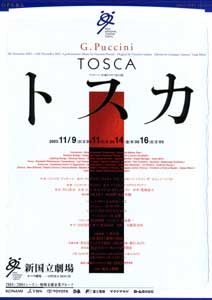|
 Tosca
is a drama of love and hatred, which portrays the tragic destiny
that hastens two lovers toward death. NNTT proudly presents
the operatic masterpiece of Giacomo Puccini, whose emotionally
charged music touches the heartstrings of the audience. Tosca
is a drama of love and hatred, which portrays the tragic destiny
that hastens two lovers toward death. NNTT proudly presents
the operatic masterpiece of Giacomo Puccini, whose emotionally
charged music touches the heartstrings of the audience.
Tosca is the most dramatic of all
the operas written by the Italian composer. The sweet melody
and powerful musical orchestration provides a sad yet beautiful
portrayal of characters who are driven into a corner by harsh
destiny. Particularly moving is the superb song “Vissi
d’arte,” sung by the passionate singer Tosca,
and the valedictory song “E lucevan le stelle”
by Cavaradossi, which are demanding arias that truly test
a singer’s ability.
The audience can also look forward to this
opera as a type of “voice entertainment,” that
enables them to savor the particularities of each singer’s
voice.
Antonello Madau-Diaz’s direction portrays
the limits of love, desire and death, realizing overwhelming
dramatic effects. In the scene of Te Deum, where the excitement
of the visual developments is heightened in harmony with the
dynamic music, the prayers of the people intermingling on
the splendid stage and the strong presence of Scarpia, the
the incarnation of evil, enables the audience to enjoy the
charm of opera. The confident production and gorgeous staging
of the opera, which makes full use of the NNTT stage, will
not fail to profoundly move the audience.
<Synopsis>
The setting is Rome,
which is under Austrian control, on June 17, 1800. The artist
Cavaradossi is arrested on the charge of sheltering the republican
Angelotti, who escaped from prison. The chief of the secret
police Scarpia, who intends to take Tosca for himself, tortures
her lover Cavaradossi in front of Tosca and demands that she
yield herself to him in exchange for the artist’s life.
She agrees to Scarpia’s demand, successfully receives
his promise to order a mock execution of Cavaradossi, and
obtains a safe-conduct pass for her lover and herself. She
then suddently snatches a knife from the table and stabs the
police chief to death. At dawn, what is supposed to be a mock
execution is carried out, but…
|
![]()
